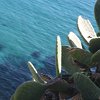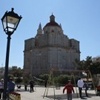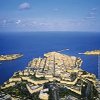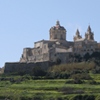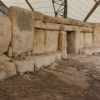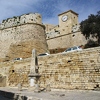MALTA - GOZO (MALTA - GĦAWDEX) ...
... an intensive and long (360 km) car tour on a small (319 sq km) islands, made between 16-23 Match, 2012.
(Text sources mostly from Wikipedia.org and from other Malta traveling sites.)
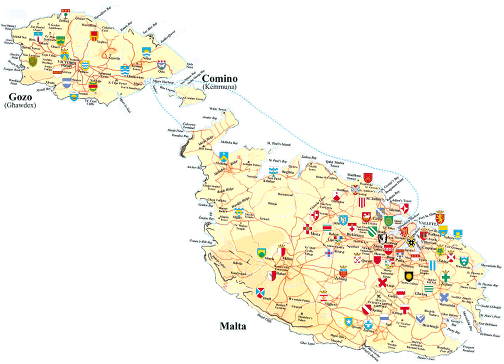
intro (plants, hotel & flight)
The Malta islands are home to many trees, some of these are native, others introduced by the knights. Native trees to the Islands are olive, Carob, Fig, and Wild almond. Others, such as conifers and Eucalyptus were introduced as a form of shade and shelter protecting land and housing. Flowering, decorative trees include the hibiscus, oleander, tamarisk, pink judas, jacaranda and yellow mimosa.Our San Antonio Hotel & Spa Malta is located in the north of Malta, in the centre of the lively resort of Qawra in St.Paul's Bay and features a Moroccan-style spa, several bars, restaurants, terraces, beach facilities and a swimming pool surrounded by palm trees facing the Mediterranean Sea.
Malta possesses its own national carrier we used, Air Malta started its flying operations on 1st April 1974 with scheduled services to London, Birmingham, Manchester, Rome, Frankfurt, Paris and Tripoli. Today Air Malta operates a modern fleet of aircraft to over 50 destinations. See more ...
17th March, 2012:
mellieħa, g.tuffieħa, red tower, mosta
Further north from St Paul's Bay on top of a hill lies the town of Mellieħa, overlooking the 'tail end' of Malta. An attractive hilltop village with a central street winding downhill. It is also surrounded by fertile valleys and most spots provide good panoramas of the countryside, the Bay with the longest beach in Malta and northwards towards Comino and Gozo.During World War II, Malta became one of the most bombed places on earth. For two and a half years, the island endured the sounding of 3,000 alerts and the dropping of over 17,000 tons of bombs. The Mellieħa World War II Shelters are one of the largest shelters complexes in Malta, dug entirely by hand and has the length of over 500 m.
St. Agatha's Tower in Malta is similar in style to the Wignacourt towers, though it was completed in 1649 during the Grand Mastership of Juan de Lascaris-Castellar to a design by Antonio Garsin. It is also known as the Red Tower due to the colour it is painted.
Popeye Village, also known as Sweethaven Village, is a group of rustic and ramshackle wooden buildings located at Anchor Bay in the north-west corner of Malta, two miles from the village of Mellieħa. It was built as a film set for the production of the 1980 live-action musical feature film Popeye by Robert Altman.
Għajn Tuffieħa forms part of the Manikata village in Malta which is part of the Mellieħa Local Council. Close to Għajn Tuffieħa three bays are located with popular beaches among tourists. The beach are separated by natural rock formations and therefore each have their own characteristics. Mosta (Il-Mosta) is a town situated in the middle of the island of Malta, to the north-west of Valletta. The main attraction in Mosta is the Rotunda - a huge round church with the third largest unsupported dome in the world. See more ...
18th March, 2012:
valetta & st paul's bay
The Porte des Bombes (Bieb il-Bombi) is an ornamental gate in the Floriana Lines, which formed the outer defensive walls of Valletta, Malta. It is situated between Pietà Creek and Marsa to the west and southeast, and the suburb of Floriana to the east.Situated in Floriana, the Argotti Gardens were laid out in the 18th century as a private garden belonging to Grand Master Pinto. The gardens became botanical a century later, with a rich collection of trees and shrubs from oaks to oleanders and potted plants, especially cacti.
The so called fosse or grain silos were dug in the rock at the time of the Order as part of the military strategy to store grain for use in case of a siege.
Malta achieved independence from the UK on 21 Sep 1964. The monument was erected in 1989 to the design of Maltese sculptor John Bonnici. Behind the Monument are the Maglio Gardens a narrow enclosure, 400 metres long, created in the mid-16th century by the French Knight Jean Lascaris. It was used for a version of croquet called palla e maglio (or pall-mall), in which a ball was driven through an iron ring suspended at the end of a long alley. The gardens contain statues of famous Maltese.
The Triton Fountain is the central feature in City Gate Square, Valletta, capital of the Mediterranean island of Malta. This square also serves as the island's central bus terminus. The Triton Fountain was sculpted by local sculptor Vincent Apap in 1959.
The city contains several buildings of historic importance: the most noteworthy being St John's Co-Cathedral, formerly the Knights' Conventual Church; Castille Place (The Prime Minister's offices), the fortifications built by the Knights to protect the city from attack, the former Grand Master's Palace (now housing the Maltese Parliament), and the National Museum of Fine Arts. It is designated as a UNESCO World Heritage Site. See more ...
19th March, 2012:
mdina and rabat
Mdina is the old capital of Malta. Mdina is a medieval walled town situated on a hill in the centre of the island. Punic remains uncovered beyond the city’s walls suggest the importance of the general region to Malta’s Phoenician settlers. Mdina is commonly called the "Silent City" by natives and visitors. The town is still confined within its walls, and has a population of just over three hundred, but it is contiguous with the village of Rabat, which takes its name from the Arabic word for suburb, and has a population of over 11,000.Rabat (Ir-Rabat) is a village just outside Mdina. The name of the village is derived from the Arabic word for 'suburb', as it was the suburb of the old capital Mdina. Rabat is home to the famous Catacombs of St. Paul and of St. Agatha. The mosaic pavements in the Domus Romana (Roman house) at Rabat rank among the finest and oldest mosaic compositions from the western Mediterranean, alongside those of Pompeii and Sicily. The beautiful St. Paul's Church in Rabat stands above a grotto where St. Paul is said to have taken refuge after his shipwreck on Malta. See more ...
20th March, 2012:
grottos, gardens & megaliths
The natural picturesque grotto and its neighbouring system of caverns mirrors the brilliant phosphorescent colours of the underwater flora. The Blue Grotto is located near "Wied iz-Zurrieq" south of the town of Zurrieq.The Buskett Gardens are located in the fertile valley of Wied Il- Luq, Siġġiewi. The gardens are at their best in the spring but they offer shade from the harsh mid-summer sun and offer a quiet place for a walk in the winter months. Verdala Palace, an official residence of the President of Malta, is located on the edge of the Gardens.
The Megalithic Temples of Malta are a series of prehistoric monuments in Malta. Archaeologists believe that these megalithic complexes are the result of local innovations in a process of cultural evolution. This led to the building of several temples of the Ġgantija phase (3600-3000 BC). Ħaġar Qim stands on a ridge some two kilometers away from the villages of Qrendi and Siggiewi. L-Imnajdra temples lies in a hollow 500 metres from Ħaġar Qim. It is another complex site in its own right, and it is centred on a near circular forecourt.
Ħal Tarxien is a small village in the south east of Malta. The etymology of the village may be a corruption of Tirix, meaning a large stone, similar to those used for the village's noted temples. See more ...
21th March, 2012:
gozo
Gozo is a great example of good things coming in small packages. A satellite of Malta, this tiny island is just 14 kilometres long and 7 kilometres wide. But its sights-per-mile ratio rivals that of Rome and Egypt.The cream of the crop are the Ggantija Temples at the end of the Xagħra Plateau. Dating back to 3,600 BC, these ancient structures are the oldest freestanding temples in the world. Just up the coast you’ll find Ggantija’s rival for the title of Gozo’s top sight – Calypso Cave. It’s mentioned in Homer’s Odyssey as the place where Greek king, Ulysses, was held as a love slave.
For all Gozo’s connections to the past, the islanders live very much in the present. Their carpe diem outlook on life means evenings are filled with feasting and weekends are full to the brim with festivals. They take every chance they get to be near the water, too. Head down to the harbour in a coastal village like Xlendi on any summer night, and you’ll find children splashing about in the shallows as their parents sip wine in waterside restaurants. See more ...
22nd March, 2012:
limestone and malta
Limestone rocks are the only mineral resource in the Maltese Islands. Various archaeological sites dating from the Neolithic period, show that limestone has always been an important resource for building purposes. Two types of limestone rocks are quarried in open cast: Softstone Quarries and Hardstone Quarries.The Limestone Heritage Park & Gardens – a celebration of Malta’s vibrant history and its unique stone resource is located in the traditional Maltese town of Siggiewi, this family-run and award-winning tourist attraction offers a fun-filled day out for all the family with plenty to see and do. See more ...
